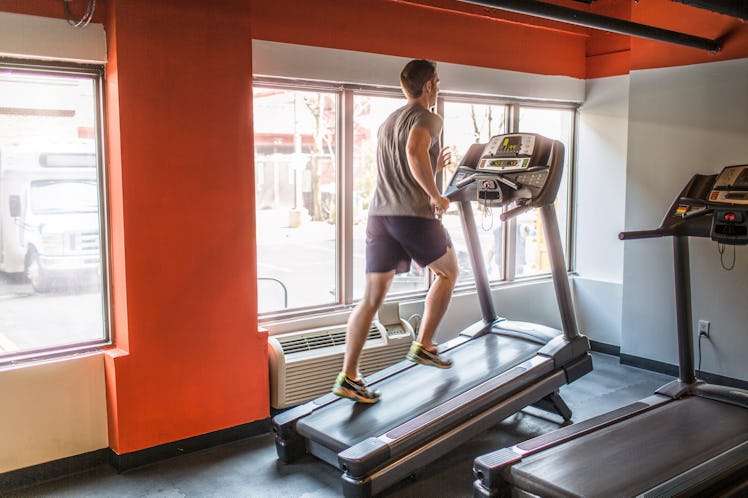The “12-3-30” Workout Is Great For Cardio. Here’s How To Make It Even Better.
Get the most out of treadmill workout-of-the-moment with these suggestions.

If you’re on TikTok, you’ve probably come across the “12-3-30” workout, a treadmill-based cardio routine that’s become wildly popular. First shared by health influencer Lauren Giraldo on on YouTube in 2019, the concept of the 12-3-30 workout is quite simple: Walk on a treadmill at an incline of 12 at a speed of 3 mph for 30 minutes, for as many times a week as you see fit.
Popularity aside, the 12-3-30 workout is an efficient routine that’s especially great for beginners. It’s lower-impact than other cardio workouts like running, which means it’s easier on your joints, and it also helps strengthen your glutes and hamstrings. Plus, the steep incline adds a nice bit of effort.
If you want to include some more cardio in your regimen, the 12-3-30 workout is a good option. But there are ways to ensure you maximize your progress — and safety. Here’s what to know about the 12-3-30 workout, and how to protect your joints while doing it, and the secret to avoiding a dreaded plateau.
The 12-3-30 Workout Is A Great Low-Impact Cardio Workout
If you’re a runner or HIIT fanatic, the 12-3-30 workout may be too easy for you. But for everyone else, it’s a good cardio option.
“The 12-3-30 workout is a good moderate-intensity workout for most people,” says Tom Walters, DPT, CSCS, author of Rehab Science: How to Overcome Pain and Heal From Injury.
The appeal of the 12-3-30 workout, Walters says, is that it’s designed for beginner exercisers, or those who haven’t laced up their sneakers in a bit. It’s also a safe option if you’re an avid exerciser recovering from an injury and starting to work out again, due to its low-impact nature. However, Walter adds, “if you’re extremely deconditioned, this may be too challenging and you may need to adjust the parameters until your cardiovascular capacity has increased.”
The numbers 12-3-30 may seem random, but they do have meaning. “This combination of variables allows for a moderate workout intensity and a length most people can fit into their daily lives,” he says. “The treadmill incline ensures it’s challenging, and the 3 mph pace means you have to walk briskly.”
The American College of Sports Medicine (ACSM) recommends moderate-intensity exercise for 150 minutes a week. So if this is the only workout you do, you should do it five times per week to hit this goal.
3 Ways To Optimize The 12-3-30 Workout
1. Don’t Neglect The Warm Up
Even though the 12-3-30 is a low-impact workout, you shouldn’t go into it cold. “When walking on an incline, the quadriceps and calves are significantly challenged,” Walters says. That means you need to stretch in order to prevent lower back and leg pain during and/or after your workout.
Before you do any stretch, it’s important to warm the muscles up with a few dynamic movements like jumping jacks or a brisk 5-minute walk. Once your muscles are warm, try these stretches before jumping into the 12-3-30 workout:
- Child’s pose: Sitting on your knees, lean forward and stretch your arms in front of you, forehead touching the floor. Hold this pose for 30 seconds. This creates a stretch in the lumbar extensor muscles, Walters says, which work with the glutes and hamstrings during exercise.
- Figure-4: Lying on your back with your feet flat on the floor, cross your right ankle over your left knee with your right foot flexed. Pull the left knee toward your chest and hold for 15 seconds before switching sides.
- Standing runner’s stretch: Start in a lunge position, with the right foot back and straight, heel as close to the ground as possible. Hold for 15 seconds before switching legs.
2. Do Strength Training To Keep Your Joints Healthy
“This workout is great for the cardiovascular system, but it doesn’t offer much for building muscle strength,” says Walters. Strength training is what will keep your lower body strong and safe to walk at a steep incline, so it’s important not to skip it if you plan on making the 12-3-30 workout your main form of cardio.
Walters suggests adding in a full-body resistance training workout two to three times per week. To save time while increasing your heart rate and calorie burn, include compound exercises (moves that use multiple muscles groups at the same time), such as squats, deadlifts, lunges, chest press, and bent-over rows.
3. Don’t Make It Your Only Form of Cardio
“Overall, the 12-3-30 workout is a great option for individuals who are looking to improve their cardiovascular fitness, burn calories, and get in shape,” Walters says. However, it isn’t all you need, especially as your fitness improves over time.
In addition to strength training, which offsets age-related muscle loss, Walters suggests alternating with higher-intensity workouts one to two times per week. Depending on your fitness level, you can do this right away or slowly incorporate high-intensity exercise into your routine as you adapt. (For beginners you can use the four- to six-week rule as a benchmark of when you’ll be ready for high-intensity workouts.) These can include high-intensity interval training (HIIT), running, or something else.
“The key is to elevate your heart rate and that cardiovascular demand,” Walters says. This will improve your strength and endurance, and help you accelerate fat loss. Sticking with the 12-3-30 workout and only it over time won’t achieve the same results.